NSTA's K-College Science Education Journals: January 2014 Issues Online
By Lauren Jonas, NSTA Assistant Executive Director
Posted on 2014-01-09
Communicating science—NSTA’s journals are all about it this month—helping children be captivated by the wonders of science, empowering them to share, and making science relevant to students as they grow into responsible citizens. The links below will take you to science education resources written by educators, for educators. NSTA’s January 2014 journals are live online (with select articles being free for all, and full content being free to all NSTA members). Browse these issues for classroom-tested ideas, activities you can use tomorrow, and commentary from experts in the field. And if you feel inspired, please keep the communication flowing in both directions—we’d love your comments on what you liked, didn’t like, and especially on what works in your classroom!
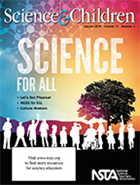 Science and Children
Science and Children
All students must be provided with equitable opportunities to be captivated by the wonders of science. This month’s issue is filled with resources for making science in your classroom engaging, inclusive, and accessible to all.
Featured articles (please note, only those marked “free” are available to nonmembers with out a fee):
- Culture Matters in Science Education
- Free – Editor’s Note: Science for All
- Free – Let’s Get Physical
- NGSS for English Language Learners
- The Power of Multimodal Representations
- What’s the Weather Like Today?
- Full Table of Contents
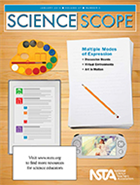 Science Scope
Science Scope
Providing students with a variety of ways to communicate their ideas and share their knowledge helps build their confidence and keeps them engaged. Check out the activities in this issue for creative ways for students to express themselves in the science classroom.
Featured articles (please note, only those marked “free” are available to nonmembers without a fee):
- Free – Editor’s Roundtable: Meet Me in the Middle in Boston
- Engage. Elaborate. Evaluate! Virtual Environment-Based Assessments of Science Content and Practices
- Every Assessment Tells a Story
- Science + Art = Enhanced Learning Experiences for Students
- Standardized Test Questions: A Tool for Developing Students’ Proficiency With the Framework’s Science Practices
- Stomp Rockets: A High-Impact Exploration of Science Concepts
- Supporting Linguistically Diverse Students in an Era of Science Education Reform
- Free – The Leonardo Strategy: Scientific Discourse and Argumentation in an Online Environment
- Using Place-Based Inquiry to Inspire and Motivate Future Scientists
- Full Table of Contents
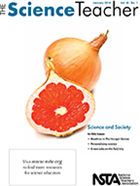 The Science Teacher
The Science Teacher
Teaching science has important implications for human society and the future of our planet. All students will need to make ethical decisions about complex socio-scientific issues that arise as a consequence of new science and technology. This issue of The Science Teacher focuses on bioethical issues such as genetic engineering, access to health care, and personal medical decisions. Students will also need to be able to think critically about energy allocation, individual resource consumption, climate change, access to food, and distribution of scarce resources. By emphasizing these socio-scientific connections, we help students learn important content while developing their ability to make informed decisions about critical issues. This edition of the journal will help you bring the necessary emphasis to your own classroom.
Featured articles (please note, only those marked “free” are available to nonmembers without a fee):
- Free – Career of the Month: An Interview With Ecosystem Scientist Stan Wullschleger
- Classification
- Free – Editor’s Corner: Crosscutting Patterns
- Science Challenge Day
- Science Immersion
- What Makes Us Tick…Tock?
- Free – Where’s That Dolphin?
- Full Table of Contents
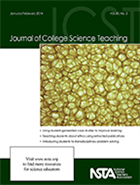 Journal of College Science Teaching
Journal of College Science Teaching
Given the financial pressures faced by many colleges and universities, the hiring of temporary faculty has become more common; read about the challenges and benefits of being an adjunct professor in Ann Cutler’s Editorial and in Robert Liftig’s Point of View. Don’t miss the article on an outdoor environmental project designed to connect with students’ real-world experiences in the Two-Year Community column. And don’t forget to read the Research and Teaching article on a new instructional model that focuses on teaching students to use foundational principles rather than rely on a multitude of facts to improve their understanding of core scientific concepts.
Featured articles (please note, only those marked “free” are available to nonmembers without a fee):
- A Multidisciplinary Laboratory Course in Color Science
- Free – Editorial: Good Help Is NOT Hard to Find
- Introducing Transdisciplinary Problem Solving to Environmental Management Systems and Geology Students Through a Case Study of Disturbed Coastal Systems
- Remeasuring Postsecondary Teaching: How Singular Categories of Instruction Obscure the Multiple Dimensions of Classroom Practice
- Research and Teaching: Collaborative Testing: Evidence of Learning in a Controlled In-Class Study of Undergraduate Students
- Research and Teaching: Principles, First and Foremost: A Tool for Understanding Biological Processes
- Student-Generated Cases: Giving Students More Ownership in the Learning Process
- Free – Teaching About Ethics and the Process of Science Using Retracted Publications
- Teaching Science and Mathematics: Preservice Teachers’ Perceptions of Knowledge Needs
- Full Table of Contents
Communicating science—NSTA’s journals are all about it this month—helping children be captivated by the wonders of science, empowering them to share, and making science relevant to students as they grow into responsible citizens. The links below will take you to science education resources written by educators, for educators. NSTA’s January 2014 journals are live online (with select articles being free for all, and full content being free to all NSTA members). Browse these issues for classroom-tested ideas, activities you can use tomorrow, and commentary from experts in the field.
Science and society
By Mary Bigelow
Posted on 2014-01-09
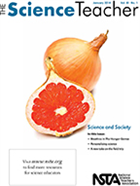
As the editor notes: “All students will need to make ethical decisions about complex socio-scientific issues that arise as a consequence of new science and technology.” So how does this translate to the classroom? The featured articles in this month’s issue describe several classroom-implemented lessons and units that go beyond the presentation of content to including the processes of analysis and argumentation—helping students exmine issues and develop their ability to make informed decisions.
Using popular fiction as a context for evaluating the effects of genetic engineering is the focus of Bioethics in the Hunger Games. The authors provide connections between the book and science concepts. They include assessment prompts aligned with Bloom’s Taxonomy and a chart that could be shared with students on determining the credibility of their sources. The culminating activity is round table format for presenting student arguments. There are suggestions for setting up and using a round table presentation (including a rubric). [SciLinks: Genetic Engineering]
Justifying a position on socio-scientific topics through argumentation is also the featured process in Beyond “My Opinion Versus Yours.” The article includes a strategy called the Silent Debate, in which pairs of students support their arguments by writing on a piece of paper that they pass back and forth. I can see how this idea prevents shouting matches and allows all students to participate, not just the more vocal ones. [SciLinks: Bioethics]
This month’s Green Room column has suggestions for going Back to Ecological Basics. The author’s big picture: To function, all organisms and ecosystems rely on a constant cycling of matter. How can human behaviors affect these cycles? [SciLinks: Water Cycle, Carbon Cycle, Nitrogen Cycle, Phosphorous Cycle]
I was intrigued by the subtitle of A New Take on the Field Trip: A low-tech, inquiry-based virtual field experience. The author describes a process she used to create a virtual field experience that could be replicated for any topic and subject area. She provides a step-by-step procedures for planning, constructing, and sharing the experience. Although her examples feature on earth science, the process could be applied to any content area (a trip inside the cell?). The extension is also interesting: Having students use the process to create experiences. This could be an authentic assessment opportunity. In this month’s Connections the author shares a sample virtual field experience and more suggestions. [Use SciLinks to find graphics, maps, simulations on a variety of topics]
Perhaps students could take a virtual trip to explore Micro World. The article describes a study of microfossils and pollen, and I learned a new word—palynology, the study of ancient or modern pollen from 5 to 500 microns. [SciLinks: Foraminifera, Fossil Pollen]
Personalizing Science includes four lessons and five strategies for engaging students in socio-scientific issues. The author includes a matrix showing how the five strategies mesh with lessons on food choices (nutrition), heart transplants (circulatory system), herbal supplements (organic compounds), and Huntington’s Disease (molecular genetics) and were implemented in core science courses. [SciLinks: Nutrition, Circulatory System, Organic Compounds, Genetics]
Learning about shapes, with tips from a special education teacher
By Peggy Ashbrook
Posted on 2014-01-08
Working in a school with teachers who have a different expertise than I have means I have access to an informal professional learning community’s broader depth of knowledge. Early childhood teachers represent a wide variety of cultures, ages and educational backgrounds. This variety is a strength when we learn from each other.
Sara Fritel Johnson is an early childhood educator with graduate degrees in early childhood special education and reading. She has worked extensively with public and private school children ages 2 to 8 years old. I asked her how I can best support all children’s learning when I model teaching science activities, such as the one on the movement of 3-D geometric shapes in the January issue of Science and Children, and she agreed to be a guest on this blog in interview form. Welcome Sara!
Peggy: When introducing preschoolers to new vocabulary words such as names for geometric shapes, are there any tips for helping children master the pronunciation and remembering the names?
 Sara: Using a multi-sensory approach will help all children. You can use visuals, real materials, whole body movement or smaller movements to help them remember new vocabulary words being taught. I think it is especially important to let them handle the materials – not just watch you as the teacher handling the materials. For example, when you are reading a book, the children can be holding shapes and when you come across “their” shape, they can hold it up or bring it to you.
Sara: Using a multi-sensory approach will help all children. You can use visuals, real materials, whole body movement or smaller movements to help them remember new vocabulary words being taught. I think it is especially important to let them handle the materials – not just watch you as the teacher handling the materials. For example, when you are reading a book, the children can be holding shapes and when you come across “their” shape, they can hold it up or bring it to you.
Peggy: How can we help children who have fine motor difficulty manipulating ramps and rolling objects, or using scissors, participate in these activities?
 Sara: When manipulating ramps and rolling objects, some children can be accommodated by using larger balls (e.g. golf ball instead of marble or 4 inch ball instead of golf ball). If they are having difficulty manipulating ramps, you could hold one end while they hold the other. You could also have children describe how they want them placed and then put them in place using hand over hand assistance (your hand over their hand).
Sara: When manipulating ramps and rolling objects, some children can be accommodated by using larger balls (e.g. golf ball instead of marble or 4 inch ball instead of golf ball). If they are having difficulty manipulating ramps, you could hold one end while they hold the other. You could also have children describe how they want them placed and then put them in place using hand over hand assistance (your hand over their hand).
 When using scissors, if children are having a difficult time snipping paper, you can verbally prompt them “open, close; open, close.” You can also give them hand over hand assistance for this. If they are able to cut, but are having difficulty staying on a line, you can help hold the paper, so they can focus on cutting instead of having to focus on holding and cutting. Eventually, they will be able to use both hands – one for cutting and one to hold the paper.
When using scissors, if children are having a difficult time snipping paper, you can verbally prompt them “open, close; open, close.” You can also give them hand over hand assistance for this. If they are able to cut, but are having difficulty staying on a line, you can help hold the paper, so they can focus on cutting instead of having to focus on holding and cutting. Eventually, they will be able to use both hands – one for cutting and one to hold the paper.
Peggy: What are some general ways teachers can to check ourselves to ensure we are meeting the diverse needs of all the children in our classrooms?
 Sara: Ask yourself – Are all the children participating and are they engaged/having fun? If the answer is “yes,” then their needs are most likely being met. If the answer is “no,” chances are you need to reflect on your lesson and possibly talk to students to see what you can do to support their learning. Sometimes asking students, “How can I help you?” opens up the conversation for them to tell you with what they might be struggling. For example, if you are working on a cutting activity and one student is just sitting there, asking them how you can help will give them the opportunity to say what is difficult for them. If students don’t respond, I usually say, “Let me show you how we can do this,” and then give them hand over hand assistance and give them more independence as they demonstrate more confidence. If the activity is more open ended, I try to get the activity started and then encourage them to try. For example, I might say, “I am going to place a ramp here, where would you like to place the next ramp?”
Sara: Ask yourself – Are all the children participating and are they engaged/having fun? If the answer is “yes,” then their needs are most likely being met. If the answer is “no,” chances are you need to reflect on your lesson and possibly talk to students to see what you can do to support their learning. Sometimes asking students, “How can I help you?” opens up the conversation for them to tell you with what they might be struggling. For example, if you are working on a cutting activity and one student is just sitting there, asking them how you can help will give them the opportunity to say what is difficult for them. If students don’t respond, I usually say, “Let me show you how we can do this,” and then give them hand over hand assistance and give them more independence as they demonstrate more confidence. If the activity is more open ended, I try to get the activity started and then encourage them to try. For example, I might say, “I am going to place a ramp here, where would you like to place the next ramp?”
Peggy: Do you have any suggestions or resources for teachers?
Sara: Having developmentally appropriate expectations for each student is essential.
Occupational therapist and trainer Dr. Marianne Gibbs’ website, Write Out of the Box, offers developmentally appropriate information on fine motor skills. (Check out the Tips and Teacher Feature pages!) Dr. Gibb’s Handy Handout for Parents, is also an EXCELLENT resource for teachers, about building fine motor skills that will later support handwriting.
Children’s singer-songwriter Nancy Stewart has a fun song and game to play that could go along with the January 2014 Early Years column activity. You could change the words as you teach different shapes, from “rectangles, triangles, circles and squares” to “rectangular prisms, cylinders and cubes.”
Peggy: Thank you Sara, for this information and for being a resource for all the teachers you work with.
I appreciate Sara’s help in recognizing the diversity of student needs in the classroom. “Promoting meaningful and inclusive participation of individuals with exceptionalities in their schools and communities” is an ethical principle for all teachers who work with children with exceptionalities, stated by the Council for Exceptional Children.
 As the children and I work with three-dimensional shapes, I remind myself that it takes time to become familiar with any new vocabulary word. Teachers and children may stumble over the words “triangular prism” because they have always said “triangle block” to identify that shape. Posting pictures the geometric shapes along with their names helps readers remember the name and non-readers can refer to a picture.
As the children and I work with three-dimensional shapes, I remind myself that it takes time to become familiar with any new vocabulary word. Teachers and children may stumble over the words “triangular prism” because they have always said “triangle block” to identify that shape. Posting pictures the geometric shapes along with their names helps readers remember the name and non-readers can refer to a picture.
Here are a few suggestions for teacher resources—books and internet sites—with information and activities to engage children in working in three-dimensions:
Books
Building Structures with Young Children (Young Scientist Series) by Ingrid Chalufour and Karen Worth. 2004. Redleaf Press.
More than Magnets : Exploring the Wonders of Science in Preschool and Kindergarten by Sally Moomaw and Brenda Hieronymus. 1997. Redleaf Press.
Thinking BIG, Learning BIG: Connecting Science, Math, Literacy, and Language in Early Childhood by Marie Faust Evitt, Tim Dobbins, and Bobbi Weesen-Baer. 2009. Gryphon House.
Internet
The National Association for the Education of Young Children’s position statement on Developmentally Appropriate Practice (DAP), and a summary of three core considerations of DAP.
Description of how learning about geometry begins in early childhood. Clements,Douglas H. “Your Child’s Geometric World” Investigations in Number, Data and Space, TERC.
Look at these photos with children to get inspiration for building. Mississippi Heritage Trust. 2008. Geometric Shapes in Architecture.
Visit this site to see names and illustrations of 3-D shapes. Pierce, Rod. “Geometry” Math Is Fun. Ed. Rod Pierce. 6 Sep 2013. 5 Oct 2013
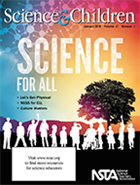 The Early Years column in the January 2014 issue of Science and Children, Shape Exploration-Another Dimension.
The Early Years column in the January 2014 issue of Science and Children, Shape Exploration-Another Dimension.
Sara also shared a game that is a favorite of the children she teaches, “Shape Monster”. The Shape Monster poem is online from several sources as a class book or game. Sara makes shapes – circles, squares, triangles, rectangles in different colors (red, blue, yellow and green) and sizes (big/little). In a 3-D version, the shapes could be balls, blocks, and other geometric shapes. Each child gets a shape or two and then they listen for their shape to be called. The teacher says,
Shape Monster, Shape Monster, munch, munch, munch.
How about a [name of shape] for your lunch?
Each child that has the named shape then gets up and “feeds” the shape monster their shape. The Shape Monster can be a large drawing of a monster face with a wide open mouth, or the children can build a shape monster as they decide where to place their shapes in the center of the circle.
This activity can be differentiated by asking for:
- just a color. (How about a yellow shape for your lunch?)
- just a shape. (How about a triangle for your lunch?)
- just a size. (How about a big shape for your lunch?)
- size and shape. (How about a big circle for your lunch?)
- size, shape, and color. (How about a small, red circle for your lunch?)
- two dimensional (flat) shapes or three dimensional geometric shapes. (How about a sphere for your lunch?)
A fun way to be sure all children are included while learning about three dimensional shapes!
Working in a school with teachers who have a different expertise than I have means I have access to an informal professional learning community’s broader depth of knowledge. Early childhood teachers represent a wide variety of cultures, ages and educational backgrounds. This variety is a strength when we learn from each other.
“Science and Literacy: A Symbiotic Relationship”: Featured Strand at NSTA’s 2014 National Conference on Science Education in Boston, MA, April 3–6
By Lauren Jonas, NSTA Assistant Executive Director
Posted on 2014-01-07
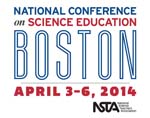 This April, the National Science Teachers Association (NSTA) will feature a special strand “Science and Literacy: A Symbiotic Relationship” at our 2014 National Conference on Science Education, in Boston, April 3–6.
This April, the National Science Teachers Association (NSTA) will feature a special strand “Science and Literacy: A Symbiotic Relationship” at our 2014 National Conference on Science Education, in Boston, April 3–6.
Attention to literacy is often seen as taking time away from science. In fact, built right into the Common Core State Standards, ELA, literacy can and should be used to enhance the effective teaching of science. Well-designed and integrated science and literacy instruction creates a symbiosis that supports classroom practice and student achievement. The investigation of science concepts within the elementary classroom enhances the development of reading, writing, and communication skills. At the upper grades, strengthened literacy skills continue to empower all students to access the science content and communicate their understanding. This strand will address how literacy and science are in service to each other across the learning continuum.
Sessions organized around this strand include a featured presentation on Saturday April 5, 3:30–4:30 PM (“Reading and Writing Science: What Should Be My Line?”) by Wendy Saul (Professor and Allen B. and Helen S. Shopmaker Endowed Chair, College of Education, University of Missouri–St. Louis: St. Louis, MO). More sessions on Science and Literacy include the following:
- ELL Strategies and How They Relate to Science Achievement Scores
- Closing the Achievement Gap with Constructed Response
- The 4Cs and Science: Incorporating 21st-Century Learning and Innovation Skills into K–12 Curricula
- Get to the Point: Techniques for Downhill Writing
- Liberating Literacy Strategies for Today’s Science Classroom
- Merging Labs and Literature: Exciting Science Lessons Linked to Great Books
- Collaborative Editing of Student Work Online in Science and English Language Arts
- Bringing Primary Scientific Literature to the Classroom Through the Journal of Emerging Investigators
- Telling a Story with Data and Visuals: Critiquing and Creating Infographics in the Classroom
- Teaching Science Through Literacy to English Language Learners and Early Childhood Kindergarten Learners
- Active Reading of Nonfiction Text
- Tricks of the Trade 4.0: Literacy Strategies to Enhance Your Science Instruction
- Discourse—Worth Discussing!
- Expand the Popular Mary Pope Osborne’s Magic Tree House Adventures by Building in Hands-On Science Activities as They Are Read
Want more? Check out more sessions and other events with the Boston Session Browser/Personal Scheduler.
 This April, the National Science Teachers Association (NSTA) will feature a special strand “Science and Literacy: A Symbiotic Relationship” at our
This April, the National Science Teachers Association (NSTA) will feature a special strand “Science and Literacy: A Symbiotic Relationship” at our
Safety Blog
Lab Incident at a Manhattan High School: Another Hard Safety Lesson to Learn
By Kenneth Roy
Posted on 2014-01-06
On January 2, 2014, a chemistry lab safety incident involving a fire injured students at Beacon High School in Manhattan (NYC). An article in The New York Times reported that two students were burned as a result of a fireball of methanol vapor created by a flame test demonstration, typically called the Rainbow. The students were sent to the hospital for medical care. This terrible accident adds to the list of safety incidents resulting from the same demonstration over the past few years.
It is absolutely tragic when students and/or school staff are injured as the result of a serious safety incident. Survivors live their lives with vivid memories and emotional and/or physical scars. In response to these accidents, there have been calls to cease hands-on science activities. This is a knee-jerk response and myopic vision. Think about it! Do we stop using cars on the highways because of automobile accidents? Do we stop flying in the sky because there have been airplane accidents? Obviously the answer to these questions is “no!” What we do is to try and make science labs SAFER; we need to help reduce or prevent future accidents by improving technology, altering human behavior, increasing safety training, and more.
Looking back at the recent lab incident and other laboratory accidents that have occurred in our schools, what is the lesson to be learned? How can we make it SAFER and how can we help reduce or prevent future accidents? Here are a few thoughts to consider and help us move in a SAFER direction while continuing the doing of science—the best way students learn it:
- Legal Safety Standards: There are legal safety standards which employers (boards of education) are required to follow. For example, the Occupational Safety and Health Administration (OSHA) requires schools under its jurisdiction with laboratories to provide ongoing employee training, appropriate engineering controls, updated administrative procedures, effective personal protective equipment, progressive discipline policies, and more under programs such as the Hazard Communications Program (29CFR 1910.1200) and the Laboratory Standard (29CFR 1910.1450). The purpose of these programs/standards is to create and maintain a safer working environment for employees, including science teachers. There are National Fire Protection Association (NFPA) fire safety standards which are adopted by state legislatures and applied to school employers relative to laboratory occupancy loads, fire suppression equipment, hazardous chemical storage, inspections, and so forth. Employers have a legal and moral obligation to address these safety standards, especially in areas like science laboratories that deal with chemical, biological, and physical hazards.
- Professional Best Safety Practices: Professions like education have safety standards that help guide science teachers to contribute to a safer working environment for themselves and their students. For example, the National Science Teachers Association (NSTA) provides a safety portal with resources, journals with monthly safety columns that deal with current safety issues (The Science Teacher’s “Safer Science” and Science Scope’s “Scope on Safety”), safety seminars at regional and national conferences, safety webinars, books on laboratory safety, and much more.
- Training: Safety is a constantly changing landscape of which professionals like science teachers need to be aware. Unfortunately, much more needs to be done at the tertiary teacher preparatory level in this area. Few colleges and universities address pre-service safety training to the level needed. Employers also need to do more to provide ongoing safety training—especially for science laboratory employees. Training should extend beyond school employees. Students must have safety training before they pick up a test tube or light a burner in the lab. They also need to sign a safety acknowledgement form recognizing that the lab can be a dangerous place. In order to make it safer, safety protocols must be practiced and followed.
- Resources: The Internet can be a life changer, if not a life saver! There are a large number of safety resources online for science teachers. As part of their professional responsibilities, science teachers need to prepare properly prior to doing laboratory experiments and demonstrations. There are government safety websites, NSTA blogs, listservs, and much more available. But, teachers should be given time to review them. Schools must provide professional development time and training to make use of these resources.
- Supervision: According to OSHA and school district evaluation programs, employees require supervision. Safety needs to be a critical piece which is addressed on a regular basis. There must also be enforcement of all safety standards to reduce the frequency of incidents and make it a safer place to work and learn.
- Equipment: Along with training there are legal safety standards and professional best practices that require access, appropriate use, and inspection and repair/replacement of safety equipment specific to laboratories (e.g. chemical splash goggles, gloves, aprons, etc.) Also required are appropriate ventilation systems, fume hoods, fire extinguishers, etc.
- Inspections: Science labs should be inspected on a regular basis to help the science teacher make sure all things are operating and functioning safety-wise. Chemical hygiene officers, school district safety compliance officers, insurance carrier inspectors, the local fire marshal, commercial safety compliance inspectors, and OSHA compliance officers—these are just a few examples of people who are committed to safety and who can help science teachers make sure their labs are up to or surpass safety standards.
- Professional Preparation/Certification: Few states now require specific professional/academic preparation standards for each area of science. The bar has been lowered and we all are paying for it. Often “science” certified teachers are assigned classes in areas they have had little to no academic preparation in or experience in teaching. Legislators need to re-examine this whole issue and get back on track. Unlike other areas such as English and mathematics, we need to require specialized certificates in each of the many science education areas—physics, chemistry, biology, etc.
Re-occurring safety incidents and serious injuries are a symptom that the system is not functioning properly. Will all of these suggestions prevent safety accidents or incidents from occurring? Maybe not, but they would dramatically reduce their frequency and make for a much safer science lab experience for our children and our science teachers.
Dr. Ken Roy
Chief Science Safety Compliance Consultant/Author/Columnist, National Science Teachers Association
On January 2, 2014, a chemistry lab safety incident involving a fire injured students at Beacon High School in Manhattan (NYC). An article in The New York Times reported that two students were burned as a result of a fireball of methanol vapor created by a flame test demonstration, typically called the Rainbow. The students were sent to the hospital for medical care.
From new teacher to colleague
By Mary Bigelow
Posted on 2014-01-02
 I’m a new teacher fresh out of college, and I took a job as a chemistry teacher in a different state. I had a good student teaching experience, so I’m okay with the students and the curriculum and I love the area, but as a newbie I feel isolated from the other teachers who already know each other. I want to establish positive relationships with the other teachers and staff, but I’m not sure how to start. (My school does not have a formal mentoring or orientation program.)
I’m a new teacher fresh out of college, and I took a job as a chemistry teacher in a different state. I had a good student teaching experience, so I’m okay with the students and the curriculum and I love the area, but as a newbie I feel isolated from the other teachers who already know each other. I want to establish positive relationships with the other teachers and staff, but I’m not sure how to start. (My school does not have a formal mentoring or orientation program.)
—Jason, Boston, Massachusetts
No matter where you teach, teaching can be a solo job. Unfortunately, once the classroom or lab door closes, you’re often on your own. But most teachers are helpful people. Your new colleagues and administrators want you to succeed, but they might be hesitant to offer advice, wanting not to offend you. They may not realize you’re new to the area. And they’re not deliberately ignoring you—they’re busy with their own challenges. Here are some things you can do to connect with your colleagues.
Greet other teachers (by name once you learn them) in the hallway or the faculty room. Re-introduce yourself and ask questions. Everyone likes to feel needed, and you can gather advice from veteran teachers: “How do you handle test make-ups?” “What do you do to engage students?” Even experienced teachers like to be recognized for their work: “Your bulletin board gave me some good ideas.” “My students were really excited about what you did in class yesterday.” This could open the door to more conversations. If teachers or administrators offer suggestions, don’t come across as a know-it-all (even if you do know it all!). If a teacher offers advice, thank them without saying “I already know that.”
During department or faculty meetings, as the “newbie” on the staff, you can observe the personal dynamics and listen to the conversations. But you don’t have to be a silent observer. Speak up and ask questions: “Why do we…?” “What would happen if…?” “What is the purpose of…?” These questions can lead to interesting discussions about school practices.
If you haven’t done so already, get on good terms with those many cite as the most important adults in the school—the office and custodial staffs. Office staff members are the “go-to” people if you have questions about school procedures, supplies, and deadlines. As a science teacher, the custodians are invaluable allies in maintaining a clean, safe, and secure lab. A friendly good morning and thank you are greatly appreciated. The school or district safety officer can also be an ally in maintaining your inventories and fostering safe practices in your lab.
Attend school functions such as plays, concerts, or sporting events. Many other teachers will also be there, and the students and parents will also appreciate your interest and support. You can also get to know other teachers by co-sponsoring an extracurricular activity or being part of a coaching staff.
If the opportunity arises, volunteer for a committee or task force. Join professional development study teams or book discussion groups. You can offer a fresh view of situations from the perspective of a newer teacher. You may have useful skills in technology, writing, or presenting. If you’re a recent graduate, your science content knowledge may include experience with cutting-edge topics.
There are those who suggest new teachers should stay out of the faculty room. I’ve been in dozens of them, and most are welcoming places where teachers socialize, relax, and talk to each other. Eat lunch with other teachers there instead of by yourself in your room (it’s not a good idea to eat in a lab, anyway). If you do find that the faculty room is a toxic pit, then by all means find someplace different to hang out. You’ll want to be around colleagues who have a positive attitude and a sense of humor.
If you’re invited to join a group for a cup of coffee or dinner, accept the invitation. These social activities help you to learn the culture of the school. Positive colleagues can provide emotional support and share their (mis)adventures as a beginning teacher.
And when you’re a veteran teacher, remember your experiences and extend a welcome to your new colleagues. They’ll appreciate it.
Photo: http://www.flickr.com/photos/jeremywilburn/5229139935/
 I’m a new teacher fresh out of college, and I took a job as a chemistry teacher in a different state. I had a good student teaching experience, so I’m okay with the students and the curriculum and I love the area, but as a newbie I feel isolated from the other teachers who already know each other. I want to establish positive relationships with the other teachers and staff, but I’m not sure how to start.
I’m a new teacher fresh out of college, and I took a job as a chemistry teacher in a different state. I had a good student teaching experience, so I’m okay with the students and the curriculum and I love the area, but as a newbie I feel isolated from the other teachers who already know each other. I want to establish positive relationships with the other teachers and staff, but I’m not sure how to start.
Cooking as science
By Peggy Ashbrook
Posted on 2013-12-31
 On the winter solstice I took a walk through the yard and thought about the amount of sunlight that it receives throughout the year. Much less these days as the silver maple has grown many feet since the year my son made and tested a solar cooker as his science class project. After he was finished with the cooker I used it for a few years to make one-pot chicken and rice dishes. Read about other young children’s solar cooking exploration in the Council for Elementary Science International’s July 2012 newsletter (page 6).
On the winter solstice I took a walk through the yard and thought about the amount of sunlight that it receives throughout the year. Much less these days as the silver maple has grown many feet since the year my son made and tested a solar cooker as his science class project. After he was finished with the cooker I used it for a few years to make one-pot chicken and rice dishes. Read about other young children’s solar cooking exploration in the Council for Elementary Science International’s July 2012 newsletter (page 6).
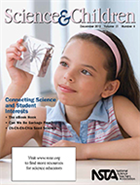 In the Early Years column in the December 2013 issue of Science and Children, I wrote about science concepts involved in cooking with young children. The children made ice cream following a recipe; touching, describing and classifying the ingredients; making measurements; and using their sense of touch to observe changes in temperature and consistency. The colder temperatures of winter make us think of warm drinks inside and frozen water outside. Explorations into changes in temperature can include “cooking” ice cream using common kitchen supplies–plastic bags, tape, salt, ice, cream and flavoring. Pair this activity using our sense of touch to observe changes in temperature with an outdoor activity such as putting cups of water in a place where they won’t be disturbed as freezing temperatures solidify the water into ice. Children also enjoy sliding ice cubes down ramps. They experience melting if they hold the ice cubes in warm hands or in warm weather.
In the Early Years column in the December 2013 issue of Science and Children, I wrote about science concepts involved in cooking with young children. The children made ice cream following a recipe; touching, describing and classifying the ingredients; making measurements; and using their sense of touch to observe changes in temperature and consistency. The colder temperatures of winter make us think of warm drinks inside and frozen water outside. Explorations into changes in temperature can include “cooking” ice cream using common kitchen supplies–plastic bags, tape, salt, ice, cream and flavoring. Pair this activity using our sense of touch to observe changes in temperature with an outdoor activity such as putting cups of water in a place where they won’t be disturbed as freezing temperatures solidify the water into ice. Children also enjoy sliding ice cubes down ramps. They experience melting if they hold the ice cubes in warm hands or in warm weather.Maureen’s blog, “Pondering Preschool” tells how her class of three-year-olds used early literacy skills and design skills as they developed imaginative play extensions of a nutrition and cooking project. They also used engineering practices as they designed and built devices to get a great big turnip out of the ground, inspired by a version of the traditional tale first recorded by Alexei Tolstoy. (Listen to a second grade class tell the story here. They were inspired by Heather Forest’s telling of the tale.)
Safety precautions are also part of cooking—the safe smelling “wafting” technique of waving the smell of a substance towards you rather than sticking your nose into it, washing hands and tasting only in cooking, not science. Creativity and science come together in growing food, harvesting and preparing it. Do you have a cooking story to tell?
Navigating the authority-figure/friend territory
By Mary Bigelow
Posted on 2013-12-27

At least these no longer apply!
What can I do to look and act more like a teacher and less like a student as I do my student teaching and begin my career? I’m wondering how to navigate the authority-figure/friend territory, especially in the case of high school students who are only a few years younger than I am.
—Lee, Pittsburgh, Pennsylvania
Your appearance and demeanor won’t automatically make you a better teacher, but they can be factors in how students perceive you.
Be sure to dress professionally, even if the teachers in the school tend to have a more casual style. You can of course be stylish and comfortable, but save the tattered jeans, t-shirts with messages, very short skirts, flip–flops, and gym wear for other occasions. Be conservative in terms of hair and makeup, if you wear it.
In addition to attire, your confidence level adds to your professionalism. Stand up straight and look the students in the eye. Use correct grammar when speaking to them and avoid using a lot of slang (although once in while the students will get a kick out of it). Practice projecting your voice so you don’t have to scream to be heard in the back of the room. Proofread any written material you give to students and parents.
As a science teacher, you’ll want to model appropriate attire for the lab, too (no open-toed shoes or dangling jewelry). I know several science teachers who wear a white lab coat on lab days. Talk about an authority figure!
Here are some suggestions from the participants in a related NSTA discussion forum:
- From Patria: I like to dress appropriately in school, but it seems that the younger teachers are into the casual wear. It depends on the school culture where you are. After several years working at the high school, I am learning to dress casually (but appropriately) on casual days or spirit days. I think the best way is to act like most of the teachers and administrators at school.
- From Tina: Although professional dress is probably called for rather than casual, if you want to project that you are an adult you must do so through your actions. There will be adults in the building who’ll mistake you for a student (and as you get older you may wish that was still true!) but what is important is how your students perceive you in class. Even in high school, if you act kind and respectful and stick to your rules students will get the idea that you are a teacher and not a classmate.
- From Monica: My experience has taught me students will be very likely to follow instructions and work hard when they know how much you care about them.Once I started to relax and enjoy them everything fell into place.
- From Molly: One thing I tell my students is that while they are in our school, they are like my own kids. I’m like a mama bear at school, and they do call me Mama. We laugh about the fact that I’m not really old enough to be their mom, but that I care about them and want them to be successful. I’ve found my kiddos like having a parental figure at school. We can laugh, joke, share some issues, but they also know the look. Many say, “My mom gives me that look!” They know when I’m serious and we need to focus, and they know when it is OK to joke.
- From Sandy: How you present yourself physically is only a small part of having students respect you. You have to have confidence in what you do and say. Talk to students with professional yet friendly language. When you write notes on the board or in a lab notebook, don’t take shortcuts and use text language. Plan your lessons ahead of time and know where the obstacles are. Be prepared to lose electricity, have a fire drill, or only a portion of the equipment you thought you would have. In this day of technology at your fingertips, don’t “friend” students on Facebook or other social media. I know there are some teachers that do so with no ramifications, but I know a whole lot more that have gotten themselves in trouble.
Most teachers would admit that the first few years are the hardest. It takes a while for you to build a reputation with students. When you are starting out you have to decide what that reputation is going to be. I had a college professor in my methods course whose mantra was “Be a fair, firm, and friendly adult.”
Photo: http://www.flickr.com/photos/spicytimothy/2118949297/sizes/l/

At least these no longer apply!
Natural hazards
By Mary Bigelow
Posted on 2013-12-26
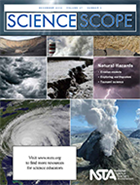 We’ve certainly had a variety of weather-related events in recent history: killer tornadoes, devastating hurricanes and floods, and fluctuating temperatures. But the “hazards” that are the focus of this issue are those related to forces that have the potential to shape and reshape the surface of the earth. The content, practices, and crosscutting concepts described in the articles relate to the NGSS performance expectation MS-ESS3-2 Earth and Human Activity.
We’ve certainly had a variety of weather-related events in recent history: killer tornadoes, devastating hurricanes and floods, and fluctuating temperatures. But the “hazards” that are the focus of this issue are those related to forces that have the potential to shape and reshape the surface of the earth. The content, practices, and crosscutting concepts described in the articles relate to the NGSS performance expectation MS-ESS3-2 Earth and Human Activity.
Many teachers have students create erosion models. Authentic Landscapes Indoors: Using Erosion Models to Connect Science and Engineering Practices goes a little further with a 5e lesson in which students observe erosion in their simulations and then design ways to prevent it. The authors provide an activity sheet and suggestions for implementation in the classroom. [SciLinks: Weathering and Erosion]
Sandwich cookies as teaching tools? I have seen lessons with the Moon’s phases depicted in Oreos (Search “oreo” and moon phases for more), but Cookie Tectonics: An Introduction to Earth Hazards and Tectonic Fundamentals introduces a “lithospheric cookie model” to review principles of plate tectonics. The authors provide a summary of important concepts in plate tectonics and a graphic organizer. And then Using Web GIS to Enhance Tectonics Learning and Geospacial Thinking, students can explore the boundaries where events such as earthquakes and volcanic eruptions occur with classroom investigations and GIS tools. Using real data and the data visualizations that are possible help students see the connections between the concepts and real events. [SciLinks: Plate Tectonics, Plate Boundaries]
With the events that happened in Japan still making news, the article Exploring Earthquakes and Tsunamis: Integrating Science, Social Studies, and Technology provides strategies for incorporating technology and reinforcing geographic concepts. The technology includes Google Earth, the Earth 101 app, an online tsunami simulator, and others suggested in the resources section of the article. [SciLinks: Ring of Fire, Tsunamis, Earthquakes]
My hometown is on the east coast of the U.S., and I never thought much about earthquakes happening in my neck of the woods until 2011 when I felt an earthquake centered in Virginia. Your students might be surprised with the real-time data on earthquake events. The author of Bringing Earthquake Engineering to Your Hometown provides a 5e lesson on engineering principles for safe structures in any location, including your own. If students wonder how or even if earthquakes can be predicted, Simulating Earthquake Early Warning Systems in the Classroom has classroom and web-based activities, including a simulation in which students decide on appropriate locations to place sensors. [SciLinks: Seismic Waves, Seismographs]
 We’ve certainly had a variety of weather-related events in recent history: killer tornadoes, devastating hurricanes and floods, and fluctuating temperatures. But the “hazards” that are the focus of this issue are those related to forces that have the potential to shape and reshape the surface of the earth.
We’ve certainly had a variety of weather-related events in recent history: killer tornadoes, devastating hurricanes and floods, and fluctuating temperatures. But the “hazards” that are the focus of this issue are those related to forces that have the potential to shape and reshape the surface of the earth.
Connecting science and students' interests
By Mary Bigelow
Posted on 2013-12-23
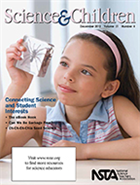 It’s hard to think of a science topic that children are not interested in! Just about anything will stimulate their thinking and inquisitiveness. The cover of this issue brought back memories of these interests—I had a set of specimens embedded in plastic blocks. Just putting some out at the exploration table in my classroom let to many discussions. (The favorites were skeletons of small bats and garter snakes.) The articles in this issue offer resources and suggested strategies for tapping into students’ interests to stimulate engaging science instruction.
It’s hard to think of a science topic that children are not interested in! Just about anything will stimulate their thinking and inquisitiveness. The cover of this issue brought back memories of these interests—I had a set of specimens embedded in plastic blocks. Just putting some out at the exploration table in my classroom let to many discussions. (The favorites were skeletons of small bats and garter snakes.) The articles in this issue offer resources and suggested strategies for tapping into students’ interests to stimulate engaging science instruction.
You know it’s the gift-giving season when commercials for Chia Pets appear on television! Who would think that these could be learning tools? Students explore the chia seed’s nutritional value and the growth requirements for its sprouts, as described in Ch-Ch-Ch-Chia Seed Science*. Using a 5e lesson, teachers and students explored concepts in germination and designed fair tests to study the factors that influence it. [SciLinks: Factors Affecting Plant Growth, How Do Plants Grow?]
The authors of The eBook Hook* describe a classroom research project in which they investigated how nonfiction eBooks could engage students in studying topics such as landforms. Students shared their perceptions of using an electronic format, in terms of finding information, the value of features such as pronunciation guides and dictionaries, and their attitudes toward reading. [SciLinks: What Are Landforms?]
Making Connections Between the Digital and Physical World* shows how a game such as “Angry Birds” can spark student interest in physical science concepts and shows that there’s more to the game than bird and pigs. While learning about the concepts, students design, test, and modify a real, 3-D version of the game. [SciLinks: Kinetic and Potential Energy, Gravity, Friction]
Even if you’ve never used the outdoors as a classroom, the article Exploring the Wild World of Wiggly Worms has suggestions for taking young students outdoors and exploring worms with a 5e lesson. They (and the teacher) can get their hands dirty while investigating earthworm habitats and behaviors. The authors also provide a list of related fiction and nonfiction trade books on the topic. [SciLinks: Earthworms]
The school cafeteria as a source of data? Can We Be Garbage Free?* describes an investigation in which students observed (without touching) waste from the cafeteria and tallied different categories. They then formulated their own questions about the type and frequency of materials thrown away. Students presented their findings and suggestions to the maintenance staff [SciLinks: Waste Management]
Additional ideas for student investigations based on students’ interests are included in the articles Our Environment* (students pose a scientific question and plan an investigation to answer that question), Catch Me If You Can (kindergarten students design a “trap” for an intruding character), Happy Birthday (students learn about seasons and the length of daylight at different times of the year when their birthdays fall), and Is It Made of Parts?* (a formative assessment probe).
Now We’re Cooking* shows how cooking and science topics are related: states of matter, measuring, properties of materials, changes in matter, fractions. The article includes a “recipe” or procedure for making ice cream. [SciLinks: States of Matter]
* Many of these articles have extensive resources to share, so check out the Connections for this issue (December 2013). Even if the article does not quite fit with your lesson agenda, there are ideas for handouts, background information sheets, data sheets, rubrics, and other resources.
 It’s hard to think of a science topic that children are not interested in! Just about anything will stimulate their thinking and inquisitiveness. The cover of this issue brought back memories of these interests—I had a set of specimens embedded in plastic blocks. Just putting some out at the exploration table in my classroom let to many discussions.
It’s hard to think of a science topic that children are not interested in! Just about anything will stimulate their thinking and inquisitiveness. The cover of this issue brought back memories of these interests—I had a set of specimens embedded in plastic blocks. Just putting some out at the exploration table in my classroom let to many discussions.




